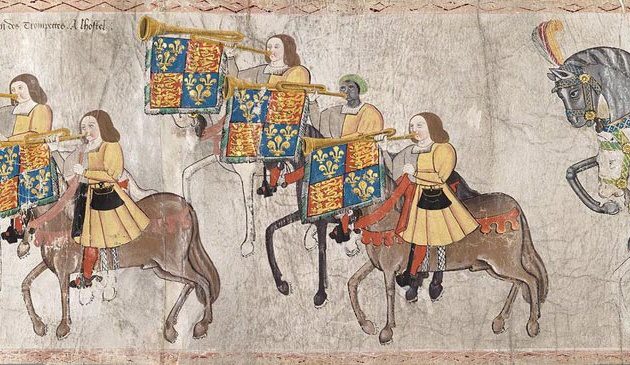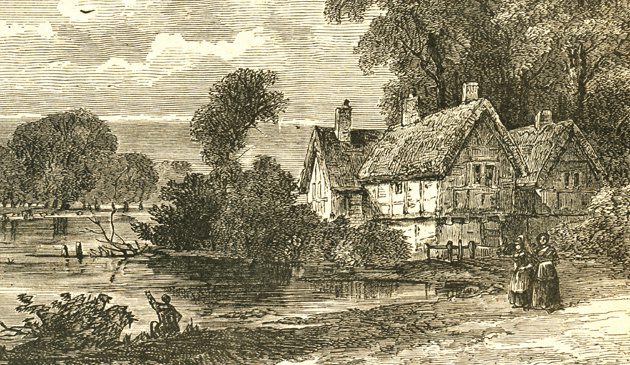Westminster Abbey in the Tudor period

The coronation procession of Anne Boleyn at Westminster Abbey on 31st May 1533, from a drawing by David Roberts. Anne was the second wife of Henry VIII to have a coronation in the abbey, the first being a joint coronation of Henry and Catherine of Aragon in June 1509. Over a period of four days of celebration Anne travelled by barge from Greenwich to the Tower of London, and then from there in a procession to the abbey. None of Henry’s later four wives were given a coronation.
Thomas Cromwell, previously an assistant to Cardinal Wolsey, was confirmed as the King’s Chief Minister in April 1534. Smaller religious houses began to be dissolved. In 1536, as the pace of the Reformation quickened, Cromwell ordered the removal of all shrines, relics and images from Westminster Abbey. The gold surrounding the coffin of Edward the Confessor went to the royal treasury and it was only his royal status that saved the main structure of his shrine. The abbey’s manors at Ebury, Hyde, Toddington, Neyte and Covent Garden were given over to the King. In January 1540 Boston and 26 monks met in the Chapter House to sign a document in which they “unanimously and of their own free will” surrendered the abbey to the King.
At its dissolution Westminster was only second to Glastonbury in wealth, with an annual income of £4,000. It was an institution filled with precious items, some dating back centuries. Thousands of items were confiscated. The monks, at least one of whom had lived in the abbey for 51 years, dispersed. Between January to December 1540 the great abbey was left empty.
That December letters patent were issued to convert Westminster Abbey to a cathedral, thus creating the City of Westminster. Although the church remained a cathedral for only a short time, the borough retained that title into modern times. The King instructed Archbishop of Canterbury Thomas Cranmer to consecrate Thomas Thirlby as the Bishop of Westminster along with various other posts including Dean of the Chapel Royal. The former abbot returned as Dean William Benson, having reverted to his family name, and six of the former monks reappeared as prebendaries. The Dean and Chapter were allotted an endowment from the former monastic lands.
Throughout the Middle Ages the abbey’s Chapter House had acted as the meeting place for Parliament. St. Stephen’s Chapel of the Palace of Westminster was also suppressed during the dissolution of religious houses and thereafter that became the meeting place of the House of Commons, with the Lords meeting in the former Privy Palace.
Henry VIII died in 1547 and his 10-year-old son Edward was crowned in Westminster Cathedral by Archbishop Cranmer. Edward was the first king to be crowned as head of the Church of England and the only one during Westminster’s time as a cathedral. Dean Benson died in 1549 and was succeeded by Richard Cox. It was a turbulent time for political matters and disagreements between Cox, Bishop of London Nicholas Ridley, and Bishop Thirlby led to the suppression of the bishopric of Westminster. Thirlby was instead appointed Bishop of Norwich.
The Protestant young Edward died in 1553 at just 14 years old. His staunchly Catholic sister Mary came to the throne and England was plunged into religious chaos. Dean Cox was arrested and sent to the Marshalsea Prison but managed to escape and flee to Frankfurt. The prebendaries also fled abroad. Prior to her coronation in October 1553 Mary had the church at Westminster thoroughly cleansed to purge it of any Protestant heresy. She refused to have the traditional Coronation Chair because it had been sat in by her heretic brother and instead had one blessed by Pope Julius III. In September 1556 the Dean and Chapter of Westminster were dismissed. In November John Feckenham, Dean of St. Paul’s, who had been imprisoned in the Tower of London during Edward’s reign, was installed as the abbot of the re-established Benedictine monastery. The shrine of Edward the Confessor that had been partly dismantled during the Dissolution was provided with a new wooden gabled structure, although it was impossible to restore it to its former splendour. Anne of Cleves, fourth wife of Henry VIII, was buried with full ritual in August 1557.
Queen Mary died childless in November 1558 and the majority of people in London rejoiced. For over 300 years thereafter the bells at Westminster were rung to celebrate ‘Foundation Day’ to celebrate its return to Anglicanism. At Mary’s funeral in the Abbey in December the Bishop of Winchester, who had officiated at her coronation, gave the sermon. It caused such displeasure that he was put under house arrest. Mary was buried in the north aisle of Henry VII’s Lady Chapel.
The coronation of Queen Elizabeth took place in January 1559. Cardinal Pole, Archbishop of Canterbury, had died on the same day as Mary and the papist Archbishop of York refused to officiate, so it was left to the Bishop of Carlisle. The ceremony was the first coronation that used English and not entirely in Latin. In May all religious houses were again dissolved. The Queen’s Commissioners gave possession of Westminster Abbey to Dean William Bill and a new charter re-affirmed as that of Henry VIII. The Queen regularly attended services after the opening of each Parliament.
Elizabeth died at Richmond Palace in March 1603 and lay there for several days before being brought by barge to Westminster. Thousands watched the procession from there to the abbey in April. Her death provides the first visual record of a royal funeral at Westminster. She was the last monarch buried in the abbey to have a monument erected there, in the north aisle of Henry VII’s chapel. Her coffin was placed on top of that of her half-sister Queen Mary in a vault below the tomb, finally bringing together the Catholic Bloody Mary with the Protestant Virgin Queen.


